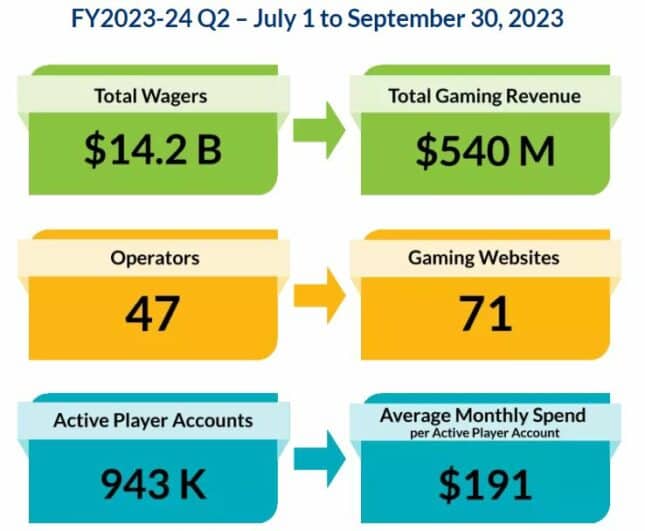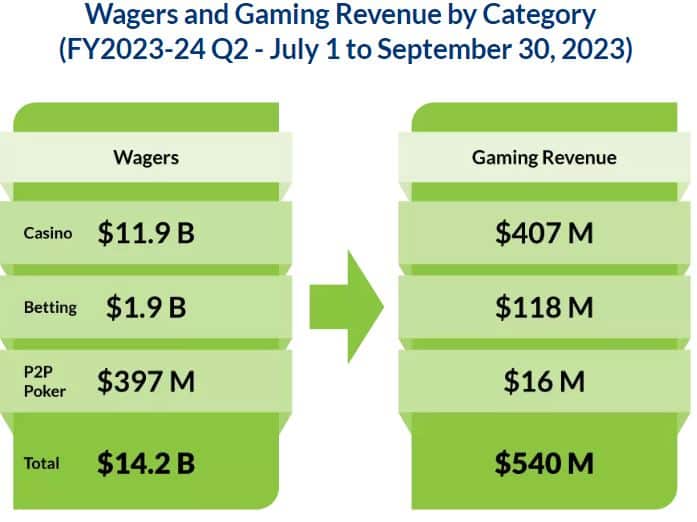
Gamblers in Ontario wagered approximately $14.2 billion and the market produced $540 million in total gaming revenue — from iCasino, online sports betting, and online poker — from July 1, 2023-Sept. 30, 2023, according to iGaming Ontario’s 2023-24 Q2 market report released on Wednesday.
The $14.2 billion in total handle does not include promotional wagers, and the total gaming revenue of $540 million includes rake fees, tournament fees, and other fees across 47 total operators and 71 active gaming websites.
Regulators are also reporting that there were 943,000 active player accounts over the three-month period with an average monthly spend of $191 per user.

It’s important to note that these figures don’t include iGaming revenue from the Ontario Lottery and Gaming Corporation, which offers its own iCasino and retail and online sports betting platform. PROLINE+ was the first online sportsbook to launch in Ontario, shortly after Canada decriminalized single-event wagering on Aug. 27, 2021.
OLG was the only legal provider of Internet gaming prior to the launch of Ontario’s regulated iGaming market on April 4, 2022, and it still expects to maintain approximately 25%-30% of the market share despite increased competition from private operators, according to a recent Auditor General report. OLG is forecasting that its Internet gaming revenue will reach $530 million (excluding Internet lottery sales) by 2025/26.
Revenue breakdown
Online casino games, including slots, live and computer-based table games, and peer-to-peer bingo, accounted for nearly $11.9 billion (84%) of total wagers and $407 million (75%) of gaming revenue during the quarter. Betting, including on sports, esports, proposition and novelty bets, as well as exchange betting, accounted for nearly $1.9 billion (13%) of total wagers and $118 million (22%) of gaming revenue. Peer-to-peer (P2P) poker accounted for $397 million (3%) of total wagers and $16 million (3%) of gaming revenue.

Market comparables
The $14.2 billion in total wagers is a 132% increase over Q2 last year, while the $540 million in total gaming revenue represents a 105% increase over Q2 last year.
At first glance, it may appear that the market stagnated when compared to Q1. However, it’s important to note that the Q2 period (July 1-Sept. 30) is the slowest period on the sports betting calendar, with many of the major sports, like hockey and basketball, in their offseasons. The NFL regular season also only got underway in early September, so the sports betting revenue generated by the regulated market should see a sizable increase in Q3 when all of the major sports are at least partially in season.
| Quarter | Total Wagers | Total Gaming Revenue | Operators | Active Player Accounts | Average Monthly Spend |
|---|---|---|---|---|---|
| Q1 2022/23 | $4.07B | $162M | 18 | 492K | $113 |
| Q2 2022/23 | $6.04B | $267M | 24 | 628K | $142 |
| Q3 2022/23 | $11.53B | $457M | 36 | 910K | $167 |
| Q4 2022/23 | $13.9B | $526M | 44 | 1.1M | $174 |
| Q1 2023/24 | $14B | $545M | 46 | 920K | $197 |
| Q2 2023/24 | $14.2B | $540M | 47 | 943K | $191 |